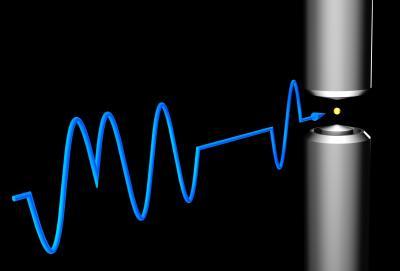The best way to get precise information regarding the inner structure of atoms and molecules is to excite them by means of resonant laser light but this laser light can lead to measurable modifications within the atom's electron shell, above a certain intensity. The act of getting the information changes the study.
Scientists of the Physikalisch-Technische Bundesanstalt (PTB) say they have now shown experimentally how to prevent such "light shifts" and that this confirms the advantages of "hyper" Ramsey excitation that had already been predicted theoretically.
"Light shift" means that intense laser light modifies the position of the atomic energy levels; the shift depends on the intensity and the wavelength of the laser used. If one is seeking the properties of the atom as an undisturbed quantum object, this shift must be either prevented or corrected. With the new procedure, which has been applied experimentally, a sequence of judiciously selected laser pulses used to excite the atom eliminates the disturbing light shift effect.
The basic idea of using pulsed radiation to perform precise measurements goes back to Norman Ramsey, who was awarded the Nobel Prize in physics in 1989 for this finding. With this method, a first laser pulse is shot at the atom, where it starts a resonant excitation. Then the pulsation excited in the electron shell of the atom continues undisturbed "in the dark" until eventually a second laser pulse completes the comparison between the resonance frequency of the atom and the laser frequency.
A similar approach is also usual in clock comparisons: two clocks are set to the same time, they are then left to run on and are eventually compared again. The result shows which clock was faster or slower than the other.

Stylized representation of the excitation of a single ion in a trap by means of a "hyper" Ramsey pulse sequence. Credit: Physikalisch-Technische Bundesanstalt
The signal of the Ramsey excitation contains, due to the dark phase between the laser pulses, an averaging over the positions of the states of the atom with and without a light shift. In principle, it would be possible to compensate for the light shift by modifying the laser frequency by exactly this quantity (exclusively) during the pulses. This, however, would not bring great improvement from a practical point of view as the precise information concerning the disturbance of the atom should be known to begin with.
In 2010, a group of scientists suggested a method they called "hyper" Ramsey excitation in order to solve this problem. This theoretical consideration has now been confirmed experimentally for the first time. In the case of "hyper" Ramsey excitation, a third laser pulse of the same intensity and the same frequency, but with an inverted phase, is inserted into the dark phase. This third laser pulse automatically compensates for possible errors which could occur due to misjudgment as regards the size of the light shift and due to small variations in the laser intensity during the light pulses.
Realizing "hyper" Ramsey excitation experimentally succeeded in an atomic transition which allows very slight frequency variations to be detected and, at the same time, exhibits a large light shift, since a high laser intensity is necessary for its excitation. It is an electrical octupole transition in the Yb+ ion which is being investigated as a basis for an optical clock. The experiment confirmed the theoretical predictions concerning the advantages of "hyper" Ramsey excitation and attained a 10,000-fold suppression of the light shift.
This opens up the possibility for the optical Yb+ clock to achieve even greater accuracy. This method could also be interesting for other researchers trying to obtain a precisely controlled interaction between atoms and laser light, for instance in the field of quantum information processing.
Published in Physical Review Letters





Comments